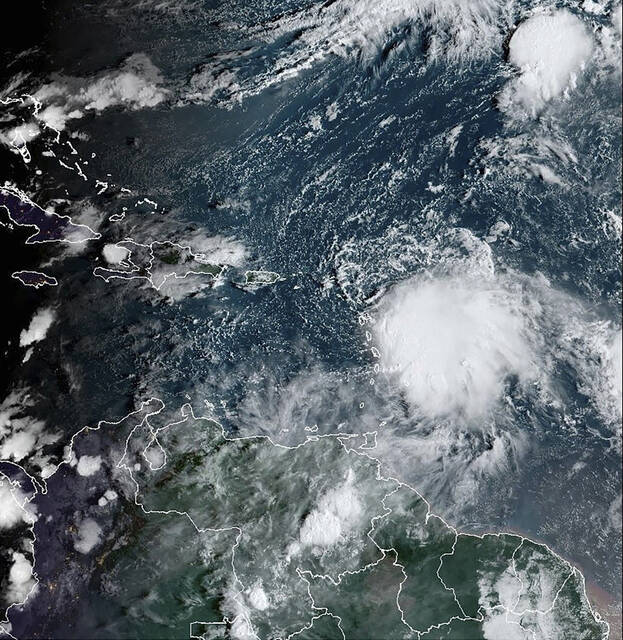FORT LAUDERDALE, Fla. — Tropical Storm Philippe began shifting away from the far eastern Caribbean islands late Tuesday afternoon, but heavy rain and strong wind are expected to continue through Wednesday, according to the National Hurricane Center.
Philippe’s maximum sustained winds were holding at 45 mph as of 5 p.m. and are expected to reach a maximum of 60 mph by Saturday, well below the 74 mph threshold for a Category 1 hurricane. Previous forecasts had Philippe reaching Category 1 strength.
Philippe made landfall in Barbuda about 6 p.m. Monday, with maximum sustained wind of 50 mph, dumping heavy rain, with some areas likely to receive up to 12 inches into early Wednesday, the National Hurricane Center said in its latest advisory.
The tropical storm warnings for Barbuda, Antigua, Anguilla and the British Virgin Islands were discontinued.
This looks familiar…latest trends show that #Philippe will be the next tropical storm to bring impacts to parts of New England and Atlantic Canada late this weekend. pic.twitter.com/q9cojmYqrM
— Collin Gross (@CollinGrossWx) October 4, 2023
As of 5 p.m. Eastern time, Philippe was 85 miles north of St. Thomas and 875 miles south of Bermuda, moving northwest at 12 mph. Its tropical-storm-force winds extended out 160 miles, largely to the east of the storm’s center, the latest advisory said.
Philippe will move more toward the north-northwest Wednesday, then take a faster northward track Thursday and Friday and approach Bermuda then, the hurricane center said.
While Philippe had begun to move away from the British Virgin Islands as of late Tuesday afternoon, the hurricane center said gusty winds are expected to continue there and in parts of the northern Leeward Islands through Wednesday.
The potential path of the storm shifted slightly to the west, “due to the storm’s resistance to begin turning,” putting Bermuda within the forecast cone, and forecasters said there’s an increasing risk for tropical storm conditions there later in the week.
There is agreement among models that Philippe may reach Atlantic Canada in about five days, forecasters said Tuesday morning.
“The risk continues to increase for some form of Philippe, likely as a post-tropical cyclone, to reach Atlantic Canada or eastern New England in about 5 days,” forecasters said in the 5 p.m. advisory.
We're looking ahead to Tropical Storm #Philippe, which now has Maine and New Hampshire in its sights.
We're LIVE tonight with what to know. pic.twitter.com/XrkxVQ3Hjl
— The Weather Channel (@weatherchannel) October 3, 2023
Hurricane Lee, which became a major hurricane in the Atlantic in early September, caused hurricane and tropical storm watches in parts of Atlantic Canada while it approached the coast and became a post-tropical cyclone before it moved across the region.
The National Hurricane Center said strong winds and heavy rainfall are likely to reach the islands to Philippe’s southeast.
The islands of the northeast corner of the Caribbean, from the British Virgin Islands through Anguilla and south to Montserrat, are expected to get 4 to 8 inches of rain, with some spots receiving as much as 12 inches.
Swells from Philippe will affect parts of the northern Leeward Islands, the U.S. Virgin Islands and Puerto Rico until the middle of the week and could cause dangerous rip currents and surf, according to the NHC.
So far this season in the Atlantic, there have been 16 named storms, six of which were hurricanes. Of those, three were major hurricanes, meaning Category 3 or above.
Check out this insane video of Tropical Storm Philippe this morning from the hurricane hunters aircraft! Lightning in a tropical system usually indicates strengthening of the storm. #Philippe is expected to maintain Tropical Storm Strength as it moves north and impacts Bermuda… pic.twitter.com/RQdUllTLG7
— WeatherNation (@WeatherNation) October 3, 2023
Those were Hurricane Lee, a rare Category 5; Hurricane Franklin, a Category 4; and Hurricane Idalia, which made landfall on Florida’s Big Bend region at Category 3 strength on Aug. 30.
The next named storm will be Sean.
Hurricane season officially runs through Nov. 30.








